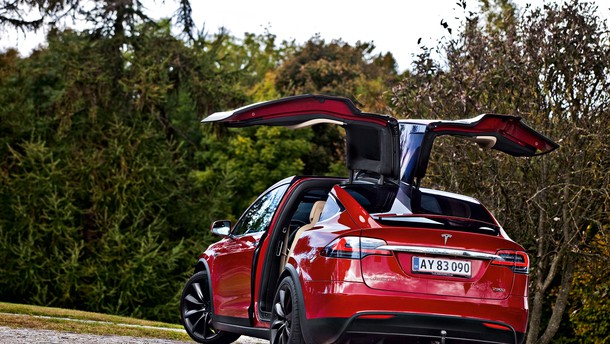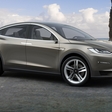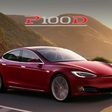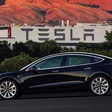

When Tesla Model S hit the streets in 2012, we were all in awe, mostly because of its outstanding range (or at least that's what we thought). The car also turned out to be very fast when accelerating. Then came Model X, and electric range barely got a mention. The key words there were the rear door, the wild acceleration and the controversial Autopilot.
One of the most electric car-friendly countries has got to be Denmark. Short to moderate distances, a well-developed network of charging stations (at the same time, Denmark is also the only country in the world that has a good coverage of hydrogen stations), low speed limits (except for the standard highway 130 km/h) and calm traffic. You'll hardly find better conditions for electric vehicles--of course, if we overlook the unbelievably backward environmental policy of the current government, which is abolishing taxes on environmentally-harmful cars and imposing more taxes on electric cars, thus destroying everything that Denmark has thus far built. It's like going back to the previous century.

Tesla Models S and X will be at the top of the list of vehicles affected. As a result, Tesla's cars sold best just before the introduction of new measures at the end of 2015, which is understandable. Irrespective of the fact that lack of support for e-mobility is silly, it's clear that models with better potential to successfully promote electric mobility, and better affordability, should get more support. That is also the reason why some countries set a price limit above which subsidies for electric cars are not available, which of course applies to Tesla Model S and X.
Needless to say, even when powered by electricity, a 2.5 ton SUV is hard to denote as truly green, as evidenced also by its official estimated energy consumption of 21.7 kWh per 100 km. In contrast, smaller and lighter vehicles revolve around a much lower value of 15 kWh or less.

The car will make it up to you for its electric gluttony with a number of great features. First place goes to its performance, of course. Acceleration time to 100 km/h is, in all honesty, shocking. When, upon activating (justifiably labeled) Ludicrous mode along with Max Battery Power mode, and when the battery reaches its optimum (mostly in terms of temperature), everything happens with the speed of lightning. Don't forget to turn off Range mode, and pay attention to both of your feet, which must play the brake and accelerator in a particular order before... Wait, don't forget to take a deep breath before stepping off the brake, or else you'll go without air until you reach 100 km/h.

Because breathing is simply impossible for a good 3 seconds, when you feel as though a three-hundred kilogram mallet landed on your chest. No, don't be surprised to see the unsuspecting passengers suddenly gripping their queasy stomachs or looking as though they're about to pass out. And what's even worse: the X P90D, which ripped the asphalt beneath our feet, is not even the most powerful Model X out there. The most recent incarnation, P100D, is even faster and can dash to 100 km/h in 3 seconds, if not slightly under. That kind of behavior will understandably leave consequences on the gauge indicating the level of energy still left in your battery. In ideal circumstances, this Model X should have, according to the outdated and hopelessly optimistic NEDC driving cycle, a range of 467 km, which you can easily ignore. In keeping with the much more realistic American EPA standard, that number should drop down to a good 400 km.
If you live in a cold climate, cut off another 50 (or more), especially if you spend much time on a highway. Higher speeds naturally devour more energy, but unfortunately not in a linear fashion. All this is something we're used to seeing in electric, as well as conventional, cars. Consumption and range vary greatly, but at the end of the day, it's your typical everyday way of driving that determines how practical and useful the electric car really is. Having said that, cars with a bigger battery and longer theoretical range are automatically at an advantage.

Its eco-consciousness also depends on where such a car will be driven and, above all, charged. Starring zero emissions, its impact on the environment is largely tied to the production of electricity that's then stored in your battery. If it's rather dirty in Germany (where, on average, a production of 1 MWh of electricity generates more than 600 kg of CO2, which will be even higher in the future, thanks to German politicians and their panicky fear of power plants), then the Danish are doing much better. The official numbers rank them as one of the cleanest nations in Europe (though not the cleanest), while a quick growth of electricity production from renewable sources (you can spot wind turbines pretty much everywhere) occasionally even exceeds demand. After all, Samso Island, which is the first bigger local community (with a population of 4000 and lots of visiting tourists) that's energy independent and CO2 neutral, is also Danish.

In terms of charging facilities for Model X, Denmark has seven stations equipped with Superchargers, which will very quickly restore your battery capacity–-up to 50% in only 20 minutes. Aside from the network of Superchargers, Tesla also set up Destination charging facilities, meant to be used when you reach your destination. These charging units are less powerful (11-22 kW), but have the advantage of causing no concern either about the connection nor the payment because, with Tesla, it works like butter.
Thanks to the Supercharger availability, Model X does perfectly well, even over longer distances, but most of the credit goes to its assistance technology. If our test Model X came with the old school hardware, then the newest versions can be ordered with specifications that will eventually enable fully-autonomous driving (after it's been sufficiently tested and legally approved by individual countries).

What about the workings of Autopilot? It certainly isn't autopilot as we know it, from the aviation industry, but it's actually a sophisticated assistance system that allows the driver to supervise the operation of the car during an autonomous drive. The system keeps the car gently in the middle of the lane, even when the roadside and center lines are badly visible (when invisible, there's more zigzagging). Every now and then, however, it deviates off course into the opposite lane. The car knows to change highway lanes (as per the driver's request, at the flick of the indicator), while also being able to autonomously accelerate, brake and adjust cruise control settings to the speed limit. Considering this is just an assistance system, the driver can go without touching the steering wheel for quite some time (we're talking minutes and kilometers, not seconds) which, at this stage of development, isn't good, in terms of safety. But on the bright side, the warning system, should you keep your hands off the wheel for too long, will intensify, asking you to take control, or shut itself down entirely until the end of your drive.
Tesla's degree of (at this point still illegitimate) confidence in Autopilot is evidenced in that the option of a fully autonomous driving function can already be ordered with your car. Tesla does warn, however, that (once available) this function won't be permitted to use for profitable activity, as in taxi driving or within the Uber system. Not a bad idea though: to be able to sprawl out on your couch, work at your desk or go for a fun day out, all while your car is making money by transporting people. Not letting any grass grow under its feet, Tesla already announced the arrival of the Tesla network system that will do just that, only under the auspices of Tesla, which will take a portion of the income.

Model X will be a perfect choice for that. Its size allows it to comfortably sit 4 or 5 passengers. A version with 6 or 7 seats is also available, though it's hard to talk about serious comfort, if you're an adult sitting in the back row. Trunk volume is then reduced to a minimum, but the absence of a barrier between the passenger's cabin and the trunk in a 6-seat version is even more of a nuisance. When the back seats are folded flat, there's an unsecured vertical opening gaping between the trunk and the car cabin, which could easily cause the luggage to fly into the passengers, in case of collision.
The cabin feels comfortable, but that could be improved upon, especially if you consider Tesla's retail price. The seats sit comfortably and are made of good materials, but can't go without occasional creaking noises, from all the rubbing of different seat components. The biggest drawback, in terms of comfort, especially at the back of the car, are the back doors. Although a great marketing idea, Falcon wing doors transmit quite a bit of wind noise through meters-worth of door sealant around them. Conventional doors with the same automatic opening would in all honesty generate more likes from us, regardless of how spectacular and eye-catching the opening and closing of the Falcon doors may be. The doors are, of course, sensitive to obstacles, and require space above the car and time. The process of opening or closing takes about 6 seconds, during which time they may occasionally come to a halt due to an "obstacle" that's not there. Interestingly, once you're behind the wheel, the doors are no longer the most spectacular feature of this car. Instead, you'll be blown away, wild acceleration aside, by a large panoramic windshield, which makes it feel like you're driving without a roof over your head, without the negatives of a convertible.

Its door opening system, which is available as part of the Premium Upgrade package, is striking. Because the car doesn't come with a conventional door handle, you'll be able to open the door (well aware of obstacles around, like cars parked next to it) by pushing a silver "button" on it. Upon touching the brake, the door will close with the help of electric motors. Considering all doors (including the trunk door) are electrically motorized, you can monitor their activity on the main LCD screen.
The LCD allows you to control almost all car functions, while its design is well-suited to be used while driving. The most impressive detail is the navigation system, for which the large screen is ideal. When you've entered your destination, the navigation software not only calculates how much of your battery you will need to reach your goal, but does likewise for the return journey. Of course, this also depends on how you drive. The 2.5 ton Model X, despite its crazy acceleration (and deceleration upon releasing the accelerator) is no sports car, but it does turn out to be extremely agile. The weight of the battery is positioned low (beneath the vehicle's floor), so it has a low center of gravity. Having wide tires, solid air suspension and excellent brakes, it's no surprise that Model X handles the curves with aplomb.

Its heft only reveals itself when the driver makes quick changes of direction (or combines turning and braking)–you can't hide from the laws of physics. And it's not hard to find yourself in that situation: the capacity of the two electric motors is exceptional. The P90D, of course, does not have as much power as is theoretically possible, considering the power of the of the front (193 kW or 262 hp) and rear (375 kW or 520 hp) electric motors. Its power is limited by the battery, and because the car comes with the possibility of using Ludicrous mode, the car has a total output of 532 hp. Tesla's engineers, when comparing to the P90D without Ludicrous mode, achieved that by adding a new fuse, which protects the battery by being able to take 1500 amps instead of 1300 amps, and with a modified software.
And it's this very software that's one of the hidden gems of the car–instead of being the same over the entire lifespan of the car, as is common with the "traditional" carmakers (where software is updated only during servicing, usually if there's a problem), Tesla provides updates via built-in data connection (which also operates in the LTE network). Thus, the car can always be updated to the latest version of the system, just as we are used to with smart phones.

And that is the essence of Tesla. The car (aside from its capacity) is actually nothing special, but in fact we mustn't look at it like a classic car (if we did, it would be difficult to forgive its shortcomings). This car is (or will be) essential to future mobility.


